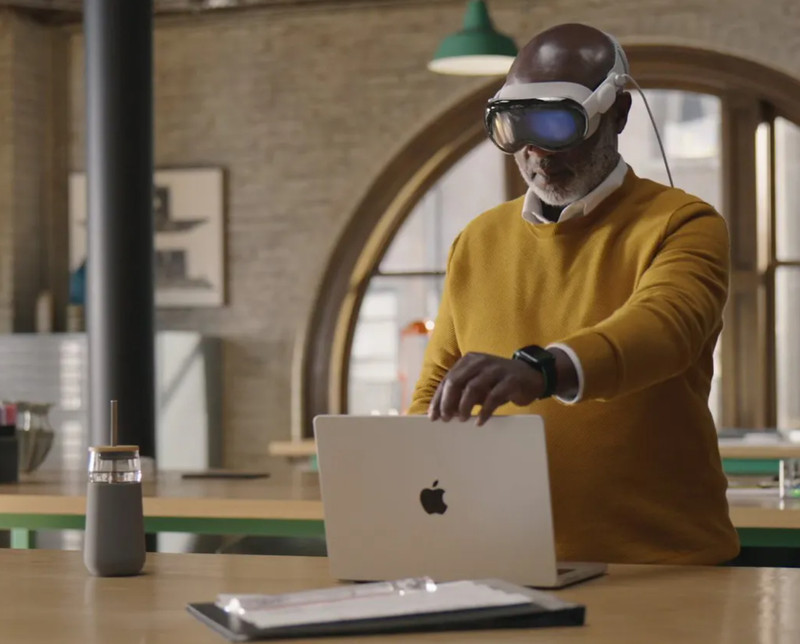Apple Vision Pro 将早于 iPhone 取代 Mac

While the $3,499 Vision Pro won’t be available for sale until next year, Bloomberg’s Mark Gurman recently reported that Apple is already working on a cheaper version. The news isn’t exactly surprising—Gurman himself previously reported on Apple’s plans to initially introduce the pricey mixed reality headset meant for developers, with a device meant for the masses released sometime later.
Gurman covers some of the ways Apple could cut costs—lower-quality screens, an older chip, and fewer cameras among them—though much of the core Vision Pro features, including the EyeSight eye tracking, will likely remain. The projected release date for this other headset is late 2025, only two and a half years from now. Gurman doesn’t mention a smaller design, but it’s hard to imagine that Apple could develop the tech in that amount of time to make a headset that’s essentially a mobile device.
That’s the eventual goal, we’ve been told—that Apple’s headset will eventually replace the iPhone. But depending on the speed of its design evolution, the Apple Vision Pro and the Apple Vision (a.k.a. the cheaper headset, following the naming scheme of the iPhone Pro and iPhone) could end up replacing the Mac a lot sooner.

Apple showed how the Apple Vision Pro can be used as a Mac display.
Apple
It’s not really mobile
As it stands now, the Apple Vision Pro isn’t a mobile device. This is based on Apple’s own demos and my very limited first-hand experience. Of course, things could change between now and its official release next year, or when the non-Pro version ships in 2025, but it’s pretty clear that the dreams of Apple AR glasses are a long way off.
Of course, there will be people who will wear it out in public (count on it), but they’ll look incredibly ridiculous and could suffer a backlash worse than Google Glass. Functionally, Vision Pro is better suited for a controlled environment, such as an office. As such, Apple’s Vision Pro demonstration focused on work collaboration, video watching, and immersive content, not on augmented reality–at least, not in the way it’s used on the iPhone, such as for walking directions in Maps.
The size and functionality mean the Apple Vision Pro is better suited for office or home use, and that also means it makes more sense to use the headset in place of a Mac. Apple might even be aware of this because, during the WWDC keynote, the company showed the Vision Pro being used as a display for a MacBook. Filmmaker Matti Haapoja, who also participated in an Apple Vision Pro demo, tweeted that “Final Cut Pro in AR” will be available for the headset. (This has not been verified by Apple.)
And editing in Final Cut Pro in AR will be available for launch editing with eyes and gestures. We freaking finally get to edit minority report styles.
— Matti Haapoja (@MattiHaapoja)
June 6, 2023
The end of the Mac and iPhone?
Does this mean that sometime in the future, we’re going to look back at the WWDC23 keynote on June 5, 2023, as the start of the end of the Mac, despite that same keynote having some big Mac announcements of its own? Maybe, but it’s going to be a long, long time from now. The Mac is a mature platform with a clear definition of what it does. Apple Vision just started its story, and it’s going to take a long time for the software to develop, hardware to evolve, and use cases to unfold. Longer than the iPhone, Apple Watch, and any new product in recent history.
But it’s clear that the killer use case, at least at launch, will be the ability to use your Mac in AR. All of Apple’s demos took place in a home or office setting, and while it only got a brief mention, the virtual Mac section was the most exciting. It’ll take time to get there, but it’s not hard to see a work where Apple sells a Mac mini-type machine that’s meant to be paired with a Vision Pro.
We must constantly remind ourselves that Apple is investing in Apple Vision for the long haul. The mistake a lot of pundits, analysts, and naysayers make is that they define the “long haul” as the next five years. It’s actually much longer than that, and this is where the generation gap is an even bigger factor. It’s unlikely that anyone reading this is going to adopt the headset as a primary platform. But what about an infant or toddler right now? By the time that child is ready to use a computing device on a consistent basis, the Apple Vision could be mature enough to fulfill that need.
And by then, as Apple Vision has entrenched itself as a viable Mac alternative, perhaps Apple will have created a version of Apple Vision that’s not that far from being like a pair of glasses. Then it can also replace the iPhone and become Apple’s primary platform.
But that’s a long time from today. A really, really long time.
